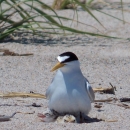Once a haven for wildlife, Poplar Island, in the mid Chesapeake Bay region, was slipping away at a rate of more than 13 feet a year due to sea level rise, land subsidence and erosion. The island was well on the way to becoming just another sand shoal.
Maps and records from the 1600’s describe Poplar Island as over 2,000 acres. The Paul S. Sarbanes Ecosystem Restoration Project at Poplar Island, more commonly referred to as Poplar Island Restoration Project, began in 1998. The goal: to rebuild the island and restore wildlife habitat using clean sediment dredged from the Port of Baltimore’s approach shipping channels.
Island habitats, important for nesting colonial waterbirds such terns and egrets and waterfowl such American black duck (Anas rubripes), continue to be lost from the Chesapeake Bay, with more than 500 Chesapeake Bay islands lost before the end of the 20th century. Some islands continue to lose greater than 8 feet of shoreline per year.
To offset this loss of valuable island habitat the U.S Fish and Wildlife Service’s Chesapeake Bay Field Office is working with partners at Poplar Island to:
- Create remote and diverse island habitat;
- Improve water habitat in Poplar Harbor to promote submerged aquatic vegetation (SAV) recovery;
- Create and enhance tidal wetlands;
- Create sparsely vegetated islands within marshes for ground nesting species such as common terns (Sterna hirundo), least terns (Sternulla antillarum), black skimmers (Rynchops niger) and oyster catchers (Haematopus palliates); and
- Create vegetated islands within marshes for nesting egrets, herons and American black ducks.
The Service’s Chesapeake Bay Field Office has been involved in many aspects of the project, including conceptual design, habitat creation, vegetation plantings, assisting with wildlife-human conflicts during construction, placement of bird nesting islands, habitat and wildlife monitoring and predator control.
At the beginning of the restoration in 1998 approximately 2 acres of island habitat was present. Now more 1,140 acres of island habitat have been created, with an additional 570 acres planned for construction. The project has also restored a 300-acre protected embayment, Poplar Harbor, on the leeward side of the island, where submerged aquatic vegetation (SAV) beds have colonized the calm, shallow water habitat.
At completion, Poplar Island will be half upland and half wetlands. Uplands will consist of forest, shrubs, meadows and freshwater ponds, all of which will support high quality habitat for a variety of wildlife species. The wetlands, a combination of tidal low and high marshes, will provide habitat for a wide range of animals including, fish, shrimp, crabs, diamondback terrapins (Malaclemys terrapin), shorebirds, wading birds and mammals. Poplar Island, once on the verge of disappearing, is now an international model for the beneficial use of dredged material and wildlife habitat restoration.
For more details, go to Poplar Island Restoration Project.
